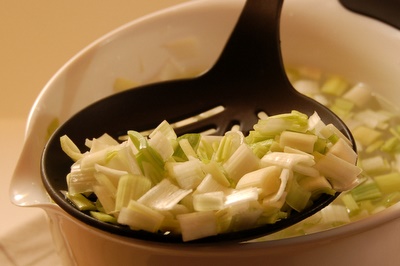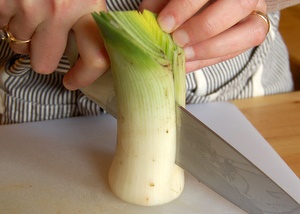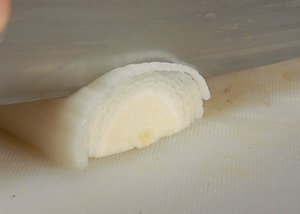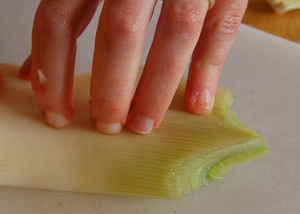 Borsh is one of the dishes most misunderstood by Americans. On this side of the Atlantic, it is known as a flavorless pink liquid that comes in a jar. I am not sure how this diluted beet juice started being sold as borsh. Where is the beef stock, the potatoes, the cabbage, the carrots, the onions, the garlic, and the tomatoes? Where is the taste?
Borsh is one of the dishes most misunderstood by Americans. On this side of the Atlantic, it is known as a flavorless pink liquid that comes in a jar. I am not sure how this diluted beet juice started being sold as borsh. Where is the beef stock, the potatoes, the cabbage, the carrots, the onions, the garlic, and the tomatoes? Where is the taste?Now the spelling... The most reasonable way to transliterate "Борщ" is "Borsh." What are all those extra consonants doing in the English version is a mystery to me. Maybe they are trying to compensate for something.
My regular cooking is mostly Mediterranean. But the chilly fall air has been giving me craving for a pot of good Russian soup. When I told my Mom that I made Borsh, she was surprised. "With all your sophisticated cuisine you have a craving for Borsh?!" After I spent 2 days making my fabulous Borsh, I was shocked that someone would think it's not sophisticated. "Who are you calling unsophisticated? Just because you can do it with your eyes closed, doesn't mean it's not a complex dish. Bouillabaisse is a piece of cake compared to Borsh!" Ok, so maybe I was getting carried away there, but a good Borsh has layers after layers of flavor and it does take longer to cook than Bouillabaisse.
Making Borsh is not hard. It's not like testing fish or steak for doneness and catching a perfect split second when it's just right. The most important cooking skill you have to have is patience. Borsh is super slow food and you can't rush it. Before I give you a recipe, let me explain the basic principle of Russian hot soups. First you need to make a stock, chill it and degrease it. Since a big pot of stock takes a while to chill, you do this a day in advance. Can you use store bought beef stock? Sure you can. But if you want the real thing, you have to make it yourself. Besides if you use store bought stock, you won't get nice tender pieces of beef in your borsh.
When your stock is made and degreased, you return it back to the heat and start adding vegetables. Potatoes and carrots go in first since they cook the longest, cabbage goes in next. There is a little controversy over when to add the beets. Traditionally, whole beets go in first (before the potatoes and carrots), they are then removed, shredded and returned to the soup. A trick I learned from my Mom, whose Borsh is the best I've ever had, is to wrap beets tightly in foil and bake in the oven until tender. Then shred them and add to the soup towards the end.
The final and most important touch, without which no Russian soup is complete is the carrot-onion flavoring. This is Russian mirepoix that appears in almost all savory hot dishes -- diced onions and shredded carrots cooked slowly in fat. For most dishes a mix of Sunflower seed oil and butter is used to cook them, but for Borsh nothing beats bacon fat. You finish this mixture with a can of tomatoes, tomato paste, and a ton of garlic. Then stir it into your soup and phew -- you are done!
It's very important to season your Borsh very generously. This is not the time for a little timid salt shaker. You have a ton of liquid here, so you'll need a ton of salt (if you want it to taste good). If you are making borsh for the first time, pour yourself a little bowl and start adding salt a pinch at a time. Taste the soup after each pinch and don't stop until the soup tastes "salty." Now remember what it tasted like right before that last pinch that tipped it over the edge. That was "perfect seasoning." Now try it with the whole pot, but stop at the "perfect seasoning" stage instead of going all the way to "salty." You'll need to add spoonfuls rather than pinches since a pot is large, but switch from tablespoons to teaspoons when you get towards the end.
Borsh (with fewer letters and more flavor)
Serves 10
For Stock:
3 large marrow bones
1 Lb beef (chuck or sirloin tips)
For Soup:
3 medium beets, trimmed and well washed, but not peeled
3 medium red skinned potatoes, peeled and cut into 1/2 inch dice
2 medium carrots, peeled, cut into quarters lengthwise, then thinly sliced
1/4 head cabbage, finely shredded
1 bay leaf
1 tsp whole black peppercorns
For Flavoring:
3 bacon strips, cut into 1/2 inch pieces
2 large yellow onions, finely diced
2 Tbsp sunflower seed (or olive) oil
3 medium carrots, shredded
1 can of crushed tomatoes, drained
1 Tbsp tomato paste
5 garlic cloves, very finely minced
For Garnish:
Sour cream
Dill and/or parsley, finely minced
Stock (prepare a day in advance):
- Place beef and bones in a large stock pot and cover with 5 quarts cold water.
- Cover and bring to a boil. As soon as the water boils, uncover and turn down the heat so that the liquid is simmering gently.
- Simmer for 3 hours, periodically skimming the brown foamy scum from the surface with a large spoon during the first 20-30 minutes of simmering or until no more impurities rise to the top.
- Chill the stock overnight. The fat will rise to the top and solidify. Remove it before making the soup.
- Remove and discard the bones.
- Remove the beef, cut it into rough chunks (about 1/3 inch big) and return to the stock.
- Preheat the oven to 375F. Wrap each beet tightly in aluminum foil and place on a backing dish (don't place directly in the oven as they might leek). Place the dish with beets in the oven and roast until tender. This can take anywhere from 1 1/2 to 2 1/2 hours depending on the size of your beets. After the first 1 1/2 hours, pierce your beets (right through the foil) with a knife. Beets will never feel as soft as potatoes, but when they are done, you shouldn't feel much resistance. If beets are not done, roast them longer. Then cool, rub the skin off with your hands (it should come right off), and shred on a box grater using large holes.
- Once the beets are out of the oven, set the stock over on the stove top and bring to a simmer. Season to taste with salt.
- Add potatoes and sliced carrots. Simmer until potatoes are tender when pierced with a knife, about 20 minutes.
- Add the cabbage, bay leaf, and peppercorns. Simmer until cabbage is tender but not mushy, about 20 minutes. While the vegetables are cooking, make the flavoring.
- Set a large skillet over medium heat. Add the bacon and fry until the fat is rendered and the bacon is starting to turn crispy, stirring occasionally.
- Add the onions and a generous pinch of salt, turn down the heat to medium-low and cook stirring occasionally until onions are tender and golden brown, about 15 minutes. If the onions are sticking, add more oil.
- Add the shredded carrots and 2 Tbsp oil and continue to cook stirring occasionally until the carrots are tender and starting to brown, 15-20 minutes.
- Add drained tomatoes and tomato paste and cook until the mixture thickens slightly, 5-10 minutes. Take off heat.
- Stir in the garlic. Taste and correct seasoning.
- Add the shredded beets and their juices to the soup.
- Add the carrot-onion flavoring to the soup.
- If the soup turned out too thick, add a little water. Stir well and take off heat.
- Taste and add more salt if needed.
- Pour into bowls, add a dollop of sour cream and a sprinkling of dill/parsley.
- Serve with good crusty bread rubbed with garlic and toasted. To make the toasts, cut a garlic clove in half, dunk in salt and rub all over the bread's crust. Then toast in a hot skillet on both sides with a couple of teaspoons of melted butter until golden and crispy.
- Instruct your guests to mix the sour cream in thoroughly with the soup. It looks pretty as a little snow pile on top of a steaming soup, but is not meant to be eaten that way. The reason we don't add sour cream into the pot is that it will curdle when the soup is reheated.
- Warn your guests about whole black peppercorns. I find it to be a nice spicy surprise when I bite into one, but not everyone agrees with me.

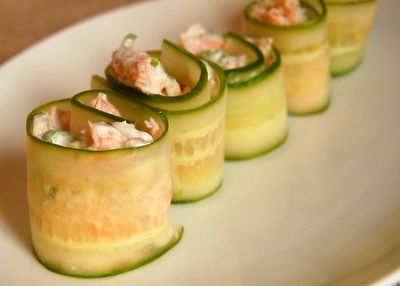 It was so cold and dreary last night that I decided to head to the closest possible fish market -- "Fishmonger" in Huron Village. In spite of it's convenient location, I don't go there more than a couple of times a year due to their early closing hours. But now that I work from home, I decided to seize my chance and see what they were up to. The shop is small and very quaint, the fish quality is excellent, the prices are sky high, and selection is limited. Yesterday's options were:
It was so cold and dreary last night that I decided to head to the closest possible fish market -- "Fishmonger" in Huron Village. In spite of it's convenient location, I don't go there more than a couple of times a year due to their early closing hours. But now that I work from home, I decided to seize my chance and see what they were up to. The shop is small and very quaint, the fish quality is excellent, the prices are sky high, and selection is limited. Yesterday's options were: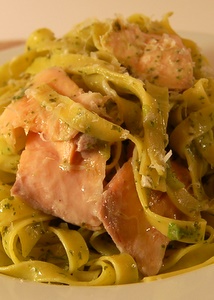

 I wish I had a picture of a turkey that Gaia and I cooked for Thanksgiving. But in the craze of finishing up the side dishes and carving our beast, we forgot all about the pictures. I’ll just have to do with a turkey leftovers sandwich for this post. I never thought a day would come when I'd be excited to write about a turkey. As you might have noticed, poultry is a rare guest on my blog. Nothing against birds, but my enjoyment of them is directly proportional to the fat content. Bird number 1 is duck – fatty, gamey, and as Julia Child would say “perfectly delicious.” But eating this heart attack on a stick on regular basis is probably not a good idea. Bird number 2 is chicken – I mean a whole roasted one (the breasts are just a vehicle for sauce). This puts turkey on the bottom of the list as number 3 – it’s too lean, characterless, and the way most people cook it, comes out dry. I like everything about Thanksgiving – the stuffing, the cranberry sauce, sweet potatoes, and pies – except for the turkey.
I wish I had a picture of a turkey that Gaia and I cooked for Thanksgiving. But in the craze of finishing up the side dishes and carving our beast, we forgot all about the pictures. I’ll just have to do with a turkey leftovers sandwich for this post. I never thought a day would come when I'd be excited to write about a turkey. As you might have noticed, poultry is a rare guest on my blog. Nothing against birds, but my enjoyment of them is directly proportional to the fat content. Bird number 1 is duck – fatty, gamey, and as Julia Child would say “perfectly delicious.” But eating this heart attack on a stick on regular basis is probably not a good idea. Bird number 2 is chicken – I mean a whole roasted one (the breasts are just a vehicle for sauce). This puts turkey on the bottom of the list as number 3 – it’s too lean, characterless, and the way most people cook it, comes out dry. I like everything about Thanksgiving – the stuffing, the cranberry sauce, sweet potatoes, and pies – except for the turkey.